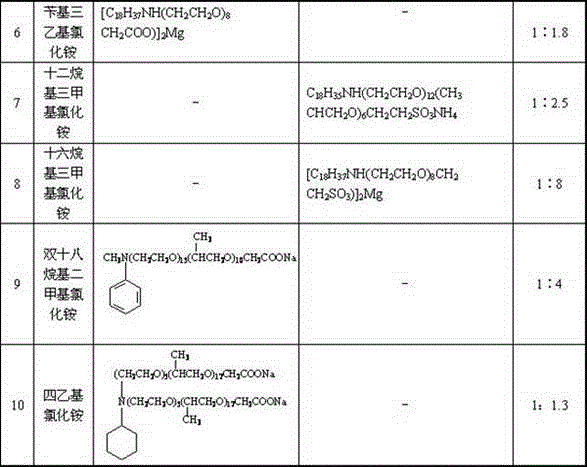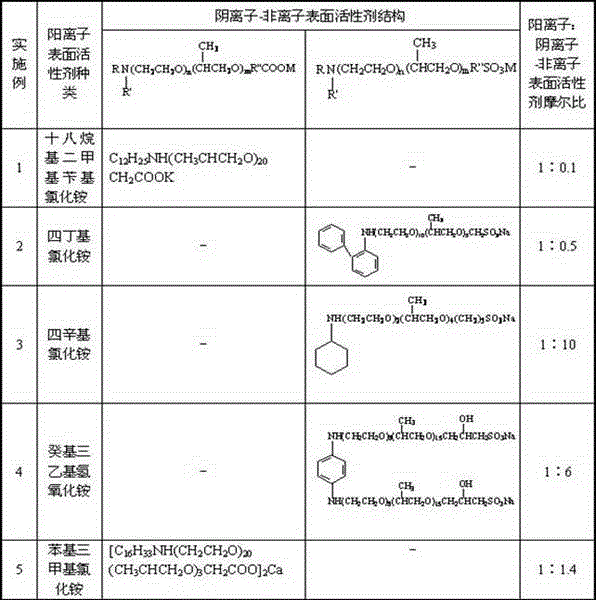Surfactant composition for tertiary oil recovery and preparation method thereof
A technology of surfactant and composition, applied in the field of surfactant composition and preparation thereof, can solve the problems of difficult demulsification of corrosion equipment and pipelines, poor oil displacement efficiency, etc., and achieves improved oil displacement efficiency, high interfacial activity, Enhanced recovery effect
- Summary
- Abstract
- Description
- Claims
- Application Information
AI Technical Summary
Problems solved by technology
Method used
Image
Examples
Embodiment 1
[0025]Add dodecylamine and KOH to the reaction kettle according to the molar ratio of 1:2, stir for 30 minutes, then add the required ethylene oxide and propylene oxide, at 200 o C was reacted for 1 hour; then chloroacetic acid was added according to the molar ratio of dodecylamine and carboxylating reagent 1:1, at 50 o After C continued to react for 20 hours, hydrochloric acid was added to neutralize to pH<3, and the layers were separated after standing, and the oil phase was neutralized by adding 30% KOH aqueous solution to obtain an anionic-nonionic surfactant.
[0026] Dissolve octadecyl dimethyl benzyl ammonium chloride and the anionic-nonionic surfactant prepared by the present invention in water respectively, stir for 30 minutes, and prepare a 0.3% aqueous solution, and then mix the above surfactants according to cationic: anionic - The molar ratio of non-ionic surfactants is 1:0.1 and mixed evenly to obtain surfactant composition 1, whose composition and structure are ...
Embodiment 2
[0028] Add o-phenylaniline and NaOH to the reaction kettle according to the molar ratio of 1:6, stir for 30 minutes, then add the required ethylene oxide and propylene oxide, at 100 o C was reacted for 20 hours; then chlorosulfonic acid was added according to the molar ratio of o-phenylaniline and sulfonating reagent 1:4, at 120 o After C continued to react for 14 hours, hydrochloric acid was added to neutralize to pH<3, and the layers were separated after standing, and the oil phase was neutralized by adding 30% NaOH aqueous solution to obtain an anionic-nonionic surfactant.
[0029] Tetrabutylammonium chloride and the anionic-nonionic surfactant prepared by the present invention were respectively dissolved in water, stirred for 30 minutes, and formulated into a 0.3% aqueous solution, and then the above-mentioned surfactant was mixed according to cationic: anionic-nonionic surfactant The molar ratio of 1:0.5 was mixed evenly to obtain surfactant composition 2, whose compositi...
Embodiment 3
[0031] Add cyclohexylamine and NaOH to the reaction kettle according to the molar ratio of 1:4, stir for 30 minutes, then add the required ethylene oxide and propylene oxide, at 160 o C was reacted for 2 hours; then sodium chloropentyl sulfonate was added according to the molar ratio of cyclohexylamine to sulfonating reagent 1:2.5, at 120 o After C continued to react for 14 hours, hydrochloric acid was added to neutralize to pH<3, and the layers were separated after standing, and the oil phase was neutralized by adding 30% NaOH aqueous solution to obtain an anionic-nonionic surfactant.
[0032] Tetraoctyl ammonium chloride and the anionic-nonionic surfactant prepared by the present invention were dissolved in water respectively, stirred for 30 minutes, and formulated into a 0.3% aqueous solution, and then the above-mentioned surfactant was mixed according to cationic: anionic-nonionic surfactant The molar ratio of 1:10 was mixed evenly to obtain surfactant composition 3, whose...
PUM
 Login to View More
Login to View More Abstract
Description
Claims
Application Information
 Login to View More
Login to View More - R&D
- Intellectual Property
- Life Sciences
- Materials
- Tech Scout
- Unparalleled Data Quality
- Higher Quality Content
- 60% Fewer Hallucinations
Browse by: Latest US Patents, China's latest patents, Technical Efficacy Thesaurus, Application Domain, Technology Topic, Popular Technical Reports.
© 2025 PatSnap. All rights reserved.Legal|Privacy policy|Modern Slavery Act Transparency Statement|Sitemap|About US| Contact US: help@patsnap.com



